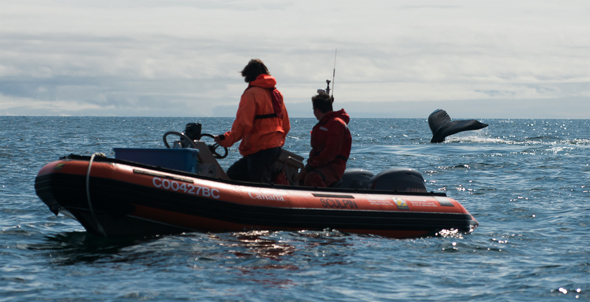
Marine mammal watching
Gwaii Haanas National Park Reserve, National Marine Conservation Area Reserve, and Haida Heritage Site
Twenty species of whales and dolphins have been recorded in Gwaii Haanas. Grey and humpback whales’ spring migration routes pass through Haida Gwaii on the way to summer feeding grounds further north.
Orca and minke whales are also seen regularly, along with dolphins, porpoises, harbour seals, and Steller sea lions. Sei, fin, and other whale species are occasionally sighted.
Whale watching guidelines

Whale watching © Parks Canada / Neil Osbourne
- Be cautious and courteous: approach areas of known or suspected marine mammal activity with extreme caution. Look in all directions before planning your approach or departure.
- Slow down: reduce speed to less than 7 knots when within 400 metres/yards of the nearest whale. Avoid abrupt course changes.
- Stay clear of the whales’ path. If whales approach you, cautiously move out of the way.
- Do not approach or position your vessel closer than 300 metres/yards to any whale.
- Stop immediately if your vessel is unexpectedly within 100 metres/yards of a whale, and allow the whales to pass.
- Do not approach whales from the front or from behind. Always approach and depart from the side, moving parallel to the whales.
- When whales are travelling close to shore, stay on the offshore side of them.
- Limit your viewing time to a maximum of 30 minutes. This will minimize the cumulative impact of many vessels and give consideration to other viewers.
- Do not swim with or feed whales.
- Aircraft should fly a minimum of 300 metres (1000 feet) above any whale.
Dolphin and porpoise guidelines
- Observe all of the guidelines for whale watching.
- Do not encourage bowriding by purposely driving through groups of porpoises or dolphins.
- Should dolphins or porpoises choose to ride the bow wave of your vessel, reduce speed gradually and avoid sudden course changes.
Sea lion and seal guidelines
- Avoid approaching closer than 100 metres/yards to any marine mammal.
- Slow down and reduce your wake/wash.
- Pay attention and back away at the first sign of disturbance or agitation.
- Be cautious and quiet when around haul-outs, especially during breeding and pupping seasons (generally May to July).
- Do not swim with or feed any marine mammals.
Related links
- Date modified :